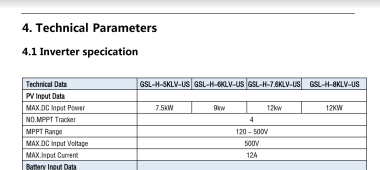It sure would be nice if Deye had some dos and don'ts on this subject.
wattmatters says some can be connected together. GXMnow says don't do it. I won't do it unless I saw something in writing from Deye.
And thanks for looking up the 7.6 GXM.
I also received a PM from someone who didn't want to join in on my Q&A I know very little thread.
He/she said the 9880 is the max watts allowed on the 7.6k. I won't need to worry about that. Keep below the 425v mppt range, not the max pv input 500v using the cold factor. If 2p, use a combiner box with surge protection 15a breakers would be fine for each string. Don't worry about going over a bit on the amps. The mppt is amp self limiting. (Who knows? The manual certainly doesn't state anything.)
I also went to rapidtables.com to calculate watts and volts into amps, of the various panels I can get. The only one that's over is the 455 watt longi at 9.13 amps, using rapidtables 18.26 if I use 2p. The others would be under using the calculator. I'm sure longi and Q.cell know there stuff, but I wonder why the discrepancy.
I would call Deye but they wouldn't understand what I'm saying anyway. Lol
It looks like I have to run wire, and tell the wife no kitchen till next year. Ha
Or be very low on panel production.



